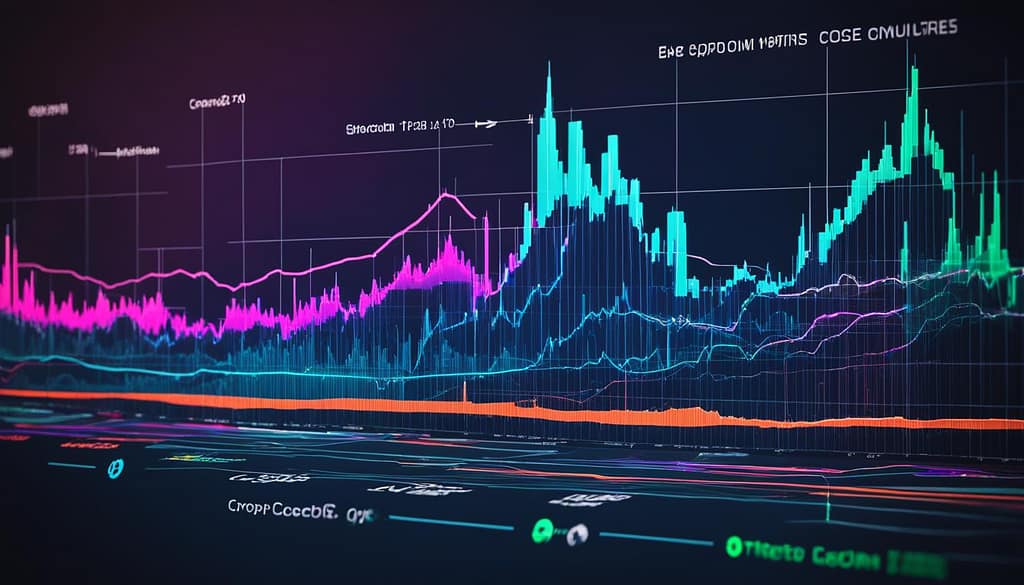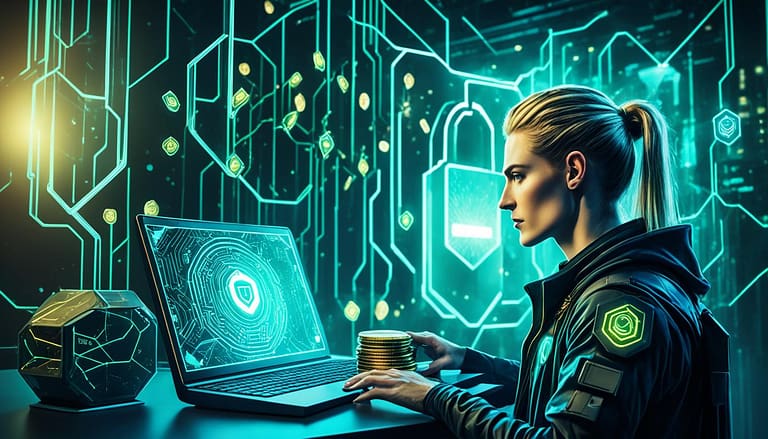Exploring NFTs and Cryptocurrency
The digital sphere is continually evolving, breaking new ground with innovations like Non-Fungible Tokens (NFTs) and cryptocurrency. The former represents a seismic shift in the concept of digital ownership, transforming the way we view and trade art, crypto art, and collectibles through an NFT marketplace. With the integration of blockchain technology, both NFTs and cryptocurrencies are redefining the landscape of digital assets, ushering in a new era characterized by secure, transparent, and decentralized transactions.
As investors and enthusiasts delve deeper into this realm, understanding the intricate nature of these technologies becomes paramount. This article seeks not only to demystify these novel concepts but also to navigate the intricate pathways of value they’ve created. Herein, we’ll dissect every facet that makes NFTs and cryptocurrencies the cornerstones of tomorrow’s digital economy.
Key Takeaways
- Non-Fungible Tokens (NFTs) alter our perception of digital ownership and asset trading.
- The NFT marketplace is an arena for artists and collectors to exchange crypto art and digital collectibles.
- Blockchain technology is the bedrock of NFT and cryptocurrency security and transparency.
- Cryptocurrency offers a decentralized approach to digital transactions, independent of traditional financial institutions.
- The synergy between NFTs and cryptocurrency has the potential to revolutionize various industries beyond the digital economy.
- Understanding the dynamics of NFTs and cryptocurrency is essential for navigating the future of digital assets.
Decoding the Hype Around NFTs and Cryptocurrency
The emergence of Non-Fungible Tokens (NFTs) and the rise of cryptocurrency have sparked a digital revolution, transforming the way we think about art, ownership, and investment in the digital economy. As formidable constituents of modern finance, these innovations owe their meteoric ascent to the robust foundation laid by blockchain technology. Here, we dissect the fervor encircling these digital phenomena and explore their impact on industries and investment landscapes.
Where cryptocurrencies like Bitcoin and Ethereum have introduced alternatives to traditional currencies, NFTs have carved their path by anchoring the notion of unique digital ownership. Unlike cryptocurrencies, which are fungible and can be exchanged with like for like, NFTs are singular in their existence. This is what makes NFT investment particularly intriguing—they are not just collectibles, but hold a value that is as unique as the asset they represent.
Equally, the world of crypto art has benefited exponentially from the proliferation of NFTs. Artists and creators find not only a platform for unfettered expression but also a new revenue model that offers direct compensation through blockchain-enabled sales and royalties.
Here’s a glance at how NFTs compare with traditional investments and what makes them a sought-after asset in the digital space:
| Asset Type | Unique Traits | Ownership Verification | Potential for Appreciation |
|---|---|---|---|
| Crypto Art (NFT) | Indivisible, provably unique | Blockchain certificate | High, subjective to market trends |
| Cryptocurrency | Fungible, divisible | Decentralized ledger | Variable, based on market dynamics |
| Traditional Art | Physical ownership | Authentication by experts | High, dependent on provenance and demand |
| Stocks/Shares | Fungible, regulated market | Securities exchange records | Dependent on company performance and economy |
This table encapsulates the unique attributes that make NFTs an attractive form of digital property. The crux of their allure is embedded in their non-fungible nature, which enjoys a symbiotic relationship with cryptocurrency transactions. Together, they are redefining the digital economy, offering novel pathways for creators and investors alike. As the market evolves, so does the enthusiasm for NFTs and the propensity for transformative blockchain technology to continue driving progress in digital asset management.
Non-Fungible Tokens (NFTs): Uniqueness in the Digital Space
The advent of Non-Fungible Tokens (NFTs) has initiated a transformative journey for digital assets, transcending traditional markets and charting a new course for blockchain technology. These digital tokens fortify the concept of unique ownership, setting the stage for distinct value appreciation and monetization possibilities within the digital realm.
Defining Non-Fungible Tokens
At the heart of the NFT phenomenon lies its defining principle – each token is a one-of-a-kind, irreplaceable entity, contrasting sharply with fungible tokens that are identical and interchangeable. NFTs leverage blockchain technology to enshrine a digital asset’s uniqueness, authenticity, and owner’s identity. This digital ledger’s transparency and security assure collectors of the immutable proof of ownership.
Real-world Applications of NFTs
NFTs are carving a niche across various sectors, such as virtual real estate, digital art, and video games. Artists and developers are exploring new frontiers of creativity, where their works can be tokenized and traded on an open market. The allure of the NFT marketplace has also engendered an innovative stream for monetization, resonating with creators and investors alike.
- Digital Art: Artists are minting their creations as NFTs, providing a new digital patronage model that rewards originality with direct royalties.
- Virtual Real Estate: NFTs function as deeds to virtual lands, opening up possibilities for building, leasing, or selling within virtual worlds.
- Video Games: In-game items and assets can now have verifiable ownership, creating an ecosystem where players can invest and trade virtual goods.
Distinguishing NFTs from Traditional Digital Assets
The NFT distinction is chiefly evident in the individuality and inherent properties of each token. With the capability to embed metadata, provenance, and a trail of ownership, NFTs present a breakthrough in the digital landscape. Traditional digital items, in contrast, lack these definitive characteristics and are subject to boundless reproduction without a mechanism to track origin and preserve value.
| Attribute | NFTs | Traditional Digital Assets |
|---|---|---|
| Uniqueness | Unique with blockchain verification | Often replicable with no unique attributes |
| Ownership | Indisputable ownership recorded on the blockchain | Ownership can be ambiguous |
| Royalties | Programmable to provide ongoing returns to creators | Royalties are rare or difficult to enforce |
| Monetization | Direct and peer-to-peer transactions facilitate monetization | Limited monetization channels |
| Trading | Traded openly on specialized platforms | Often bound to proprietary platforms with restrictions |
As we delve deeper into the intricacies of NFTs, it’s clear that their emergence is not just a fleeting trend. Rather, blockchain technology has unlocked a new dimension where the digital and tangible coalesce, engendering unparalleled opportunities for ownership, monetization, and the very essence of value in the realm of digital assets.
The Role of Blockchain Technology in NFTs and Cryptocurrency
Blockchain technology acts as the backbone for the thriving ecosystem of NFTs and cryptocurrency. By ensuring transparent transactions and the integrity of digital records, it heralds a new era of financial sovereignty where decentralized digital currencies are the norm.
With blockchain, every transaction becomes part of an unalterable public record, fostering trust and reliability. The facilitation of peer-to-peer transactions without intermediaries not only reduces costs but also hands power back to the individuals engaging in the exchange.
| Feature | Benefit |
|---|---|
| Decentralization | Reduces dependency on central authorities, empowering users with direct control over their assets. |
| Transparency | Transaction ledgers are open to all, allowing for verifiable and traceable dealings. |
| Security | Cryptographically secured to ward off fraud and unauthorized alterations. |
| Immutability | Once recorded, the data cannot be tampered with, establishing trust in data integrity. |
| Peer-to-Peer Exchanges | Simplifies transactions by eliminating intermediaries, fostering financial autonomy and inclusion. |
The resolute architecture of blockchain is not just a theoretical marvel but a practical solution reshaping the world’s financial landscapes. Amidst growing concerns around privacy and autonomy, blockchain technology provides a clear path towards a future where transparent transactions and decentralized digital currencies are universally embraced, elevating the concept of financial sovereignty to unprecedented heights.
A Deep Dive into Cryptocurrencies: More Than Just Digital Money
Cryptocurrencies have evolved from being an obscure concept to a staple in the modern financial landscape, offering more than just an alternative to traditional currency. Represented by giants like Bitcoin, Ethereum, and Tether, these digital assets are pioneering a revolution in how we conceive of and work with money.
Understanding the Value of Cryptocurrencies
The intrinsic value of cryptocurrencies lies in their capacity to enable secure, transparent, and decentralized peer-to-peer transactions on a global scale. The use of cryptography provides robust security mechanisms that make these virtual currencies near-impossible to counterfeit. This, coupled with a borderless nature, empowers individuals with newfound autonomy over their finances, unshackled from the constraints of conventional financial infrastructure.
Popular Cryptocurrencies Reshaping the Financial Landscape
The advent of Bitcoin (BTC) set the cornerstone for digital currencies, followed closely by Ethereum (ETH)—two pioneers that have reshaped and continue to strategically influence the burgeoning cryptocurrency market. Bitcoin, often referred to as digital gold, has framed a narrative of cryptocurrencies as an investment opportunity with significant growth potential. Ethereum, on the other hand, has expanded the utility of cryptocurrencies through smart contracts and decentralized applications (dApps). Tether (USDT), often used as a digital counterpart to traditional fiat currencies, provides a stable alternative to the otherwise volatile cryptocurrency market.
The Rise of Altcoins and their Market Dynamics
As the cryptocurrency ecosystem expands, Altcoins have surfaced to offer diverse functionalities. These alternative coins to the mainstream Bitcoin and Ethereum include utility tokens, which provide access to services within a network, and governance tokens, granting holders voting rights on protocol decisions. Some Altcoins leverage their niche by focusing on specific industries or utilise innovative consensus mechanisms to differentiate themselves within the market.
| Cryptocurrency | Type | Primary Use Case |
|---|---|---|
| Bitcoin (BTC) | Digital Currency | Value Storage, Investment |
| Ethereum (ETH) | Platform Token | Smart Contracts, dApps |
| Tether (USDT) | Stablecoin | Exchange Medium, Store of Value |
| Cardano (ADA) | Platform Token | Sustainable Blockchain Solutions |
| Chainlink (LINK) | Utility Token | DeFi, Secure Off-Chain Data |
The ceaseless innovation within the realm of cryptocurrencies and the introduction of Altcoins present a dynamic and evolving market rich with investment opportunities. Each token in the cryptocurrency market stands as a testament to the growing trend towards digital, decentralized currencies—signaling a significant shift in our financial infrastructure and the dawn of a new era in financial transactions.
Synergies Between NFTs and Cryptocurrency Markets
The digital asset markets are witnessing an unprecedented integration of NFTs and cryptocurrencies, presenting a harmonious relationship between the two and enabling seamless blockchain transactions. This synergy is at the heart of innovative online ecosystems, including Web3 and the metaverse, where NFT acquisitions and cryptocurrency payments are becoming increasingly commonplace. The landscape is rapidly evolving as more users understand the value of NFT investment and the utility of digital collectibles.
How NFTs and Cryptocurrencies Complement Each Other
The essence of Web3 lies in its decentralized nature, where NFTs serve as crucial cogs by representing unique value and ownership over digital items. Their non-fungible character, coupled with the fungibility of cryptocurrencies, underpins the digital economy. Crypto wallets are at the forefront of this evolution, not only facilitating cryptocurrency payments but also acting as vaults for collectors’ precious digital collectibles.
Purchasing NFTs with Cryptocurrencies
Blockchain transactions have made NFT acquisitions simple and secure, predominantly using widespread cryptocurrencies such as Bitcoin and Ethereum. The metaverse has tapped into this relationship, creating a virtual economy where digital assets are bought, sold, and traded using cryptocurrency within immersive experiences. The process of curating an NFT investment portfolio also often begins with the conversion of real-world funds into crypto assets via reputable exchanges.
As we delve further into this dynamic market, it is essential to understand how crypto wallets and NFTs are interlinked. To elucidate this connection, consider the following table outlining the role of cryptocurrency in the acquisition and management of NFT assets:
| Cryptocurrency Utilization | Role in NFT Transactions | Benefits |
|---|---|---|
| Medium of Exchange | Primary form of payment for NFT purchases | Enables quick and borderless transactions |
| Investment Vehicle | Storing value which can appreciate over time | Potential high returns on NFT and crypto pairings |
| Secure Wallet Storage | Safekeeping of acquired NFTs and cryptocurrencies | Protection and easy management of digital assets |
| Liquidity Provision | Facilitates trading and resale of NFTs | Grants NFT owners the ability to liquidate assets |
As digital collectibles continue to capture the imagination of investors and enthusiasts alike, the intersection of NFTs and cryptocurrencies is set to redefine ownership and investment in the digital realm. Crypto wallets are the lynchpin of this burgeoning digital economy, enabling users to securely manage and diversify their holdings across both NFTs and cryptocurrencies.
Investing in NFTs: Risks and Rewards
Investing in NFTs is a frontier marked by both opportunity and uncertainty. For those looking to enter the world of NFT investment, it is critical to understand the fluidity of market trends and the potential for future returns. As digital assets continue to gain traction, aligning oneself with effective investment strategies is paramount to navigating this emerging market.
A prominent feature of the NFT marketplace is its volatility, presenting a landscape where values can fluctuate significantly. This very characteristic underscores the importance of a structured approach when investing in NFTs. To mitigate risk and position for possible rewards, investors should consider the following key aspects:
- Analyzing the historical performance and consistency of an asset.
- Assessing the reputation and past creations of artists or asset creators.
- Keeping abreast of the broader economic implications shaping the digital assets sphere.
- Identifying assets that hold intrinsic value beyond their speculative appeal.
Moreover, diversification can be an effective strategy in spreading risk in the NFT domain. By acquiring a range of digital assets from different categories such as art, virtual real estate, or collectibles, one may manage risk more effectively.
| Asset Type | Characteristics | Potential for Returns | Risk Level |
|---|---|---|---|
| Digital Art | Unique, subject to artist’s reputation | High | High |
| Virtual Real Estate | Scarce, dependent on virtual world economy | Medium | Medium |
| Collectibles | Dependent on rarity and demand | Variable | Low to Medium |
It’s crucial to enter the NFT space with a long-term perspective. Short-term fluctuations are inevitable, but by focusing on digital assets with a strong foundation and clear growth potential, investors can work towards realizing substantial future returns. As with any investment, it’s advisable to perform due diligence and consider partnering with experts who can provide guidance tailored to your unique investment goals.
“The NFT marketplace is dynamic and holds vast potential for those who are adept at navigating its complexities and adapting their investment strategies to the ever-changing digital landscape.”
NFT Marketplaces: The New Frontier for Artists and Collectors
In recent times, a seismic shift has occurred in the art and collectibles world, spearheaded by the emergence of NFT marketplaces. This digital revolution has been a boon for crypto art and has effectively turned the traditional modes of asset valuation on their head. As a confluence point for digital creators, collectors, and enthusiasts, these platforms are leveraging blockchain technology to affect novel forms of blockchain transactions.
The Boom of Crypto Art
Crypto art has seen a meteoric rise, carving a niche that displays the intersection of technology and creativity. Artists from diverse backgrounds are flocking to platforms that offer an opportunity to tokenize their creations, transforming them into coveted NFT collectibles. This boom is underpinned by the paradigm-shifting capability of blockchain transactions that ensure each piece’s authenticity, traceability, and scarcity are intact, contributing to unprecedented art sales.
Collectibles and Their Value in the NFT Ecosystem
Tokenized collectibles retain intrinsic characteristics that make them highly sought-after in the NFT ecosystem. Unlike their physical counterparts, these digital assets extend beyond mere possession to enable a myriad of interactions, including trading, exhibiting, and incorporating them within various digital experiences. The table below illustrates how key factors contribute to the asset valuation of NFT collectibles in contemporary marketplaces.
| Factor | Impact on Valuation |
|---|---|
| Uniqueness | Higher value for one-of-a-kind or limited edition NFTs. |
| Provenance | Clear, verified history of ownership enhances collectible worth. |
| Utility | Functional use in digital spaces can elevate worth. |
| Creator’s Reputation | Established artists’ works often carry a premium. |
| Demand | Market dynamics and popularity drive up prices. |
| Royalties | Continuous earning potential through resale. |
The synthesis of NFT marketplaces, crypto art, and an array of digital assets have thus set the stage for a transformative era in art and collectibles sales. Artistry, once bound by material limitations, now soars in the limitless realm of blockchain technology, crafting an inclusive and vibrant ecosystem for all participants.
What the Future Holds for NFTs and Cryptocurrency Innovation
As we stand on the cusp of a new era in the digital economy, the anticipated fusion of AI integration with NFTs and cryptocurrency is expected to disrupt the existing paradigms. The promise of AI-driven technologies within blockchain ecosystems heralds an evolution of digital assets that will redefine their creation, distribution, and trade. Let’s delve into the transformative potential of AI and the immersive experiences that await in virtual environments.
The Emerging Role of AI in NFT and Cryptocurrency Spaces
Artificial Intelligence stands ready to infiltrate the blockchain, promising to bring sophistication to NFT innovation and cryptocurrency markets. AI’s profound capabilities in data analysis and machine learning are set to level-up market efficiency and security, contributing to the robust growth of decentralized finance (DeFi). Embracing AI integration, stakeholders from artists to traders can look forward to an enriched, streamlined, and more secure experience.
Prospects of NFTs in the Metaverse and Beyond
The narrative of NFTs is rapidly expanding beyond the current digital landscape into boundless virtual realms. The metaverse, envisioned as a series of interconnected virtual environments, opens up a thrilling frontier for NFTs. Within this space, NFT innovation merge with digital architecture to create immersive experiences. Decentralized finance is another sphere where the potential of NFTs shines, as it facilitates more accessible, transparent, and community-driven financial interactions.
The exploration of AI integration in these domains is not merely theoretical; it is already taking tangible form. To illustrate, here are some recent breakthroughs in AI-driven technologies that exhibit how NFTs and cryptocurrency continue to shape our digital future:
| Advancement | Impact on NFT/Cryptocurrency | Futuristic Projection |
|---|---|---|
| Smart Contract Automation | Enhanced reliability in decentralized transactions | Self-governing, error-free contracts ensuring flawless DeFi operations |
| AI-curated Artwork | Expansion of creative possibilities for NFT artists | Generative art influencing new trends in the digital art market |
| AI Analytics for Market Prediction | Strategic insights for cryptocurrency investors | AI-driven platforms that optimize investment and trading decisions |
| AI-driven Fraud Detection | Increased security for NFT transactions | Impeccable detection systems making NFT markets more trustworthy |
In conclusion, AI-induced innovation is permeating the blockchain space, revolutionizing how we interact with NFTs and cryptocurrency. As the metaverse becomes a tangible reality, we can anticipate a further fusion of technology, art, and finance, cementing digital assets as a cornerstone of our interactive virtual experiences.
Addressing Ethical and Environmental Impacts of NFTs and Cryptocurrency
The ongoing conversation surrounding Non-Fungible Tokens (NFTs) and cryptocurrency is increasingly highlighting ethical considerations and the need for environmental sustainability. This scrutiny stems from the growing awareness of the considerable energy consumption and the consequent carbon footprint of blockchain operations. As stakeholders in this expansive digital domain, it behooves us to facilitate the transition towards clean technology and energy-efficient blockchain solutions. Moreover, the notion of ethical investing is no longer a fringe concept but a central tenet for investors who are seeking to align their portfolios with their values.
In response to these imperatives, the industry is witnessing a paradigm shift towards environmentally-conscious practices. Industry leaders and developers are exploring various avenues to mitigate the environmental impacts of blockchain technology and integrate sustainability into their operations.
- Development of more energy-efficient consensus algorithms
- Greater reliance on renewable energy sources
- Carbon offsetting initiatives by blockchain companies
- Education and awareness campaigns on environmental impacts
While these solutions present a more sustainable path forward, they also open discussions on how ethical practices can be fully ingrained into the fabric of digital asset management. Accountability measures, transparent reporting on energy consumption, and actively seeking green certifications are becoming benchmarks for industry practices that reflect an emphasis on >ethical investing.
Consequently, consumer preferences demonstrate a pronounced shift. Investors and users increasingly prioritize platforms and currencies that are not only performing well but are also at the forefront of ethical and sustainable operations. This is reflected in the growing popularity of blockchain projects that possess an inherent ethos of environmental stewardship and social responsibility.
Fundamentally, as the digital financial ecosystem evolves, it must remain cognizant of its role and responsibility towards the environment and society at large. The adoption of sustainable practices, therefore, is not only a strategic move for enduring relevance and resonance with an ethically-minded audience but also an imperative for the long-term viability of blockchain technology itself.
Conclusion
Our in-depth exploration has unravelled the intricate web connecting NFTs and cryptocurrencies, highlighting the revolution brought about by blockchain technology in fostering digital ownership and enabling asset monetization. NFTs stand out with their unique identifiers, asserting the rarity and uniqueness of digital assets in a world that previously viewed digital replication as unlimited and hence, value diluted. Herein, NFTs have not only complemented but also elevated the worth of digital creations.
Cryptocurrencies continue their trailblazing journey, disrupting traditional financial avenues through blockchain technology. They serve as the backbone of transactions within the NFT space, supporting the burgeoning economies of digital assets and content. This harmonious relationship between NFTs and cryptocurrencies showcases a mutualistic relationship pivotal to the stability and growth of virtual economies.
As we peer into the future of digital assets, it’s clear that the potential for growth and innovation remains boundless. The promise of digital ownership extends beyond mere possession; it carries the torch for a new epoch wherein value is imbued in every transaction, and blockchain technology acts as the custodian of trust and authenticity. The path forward for NFTs and cryptocurrencies is paved with opportunities for creators, collectors, and investors alike, promising a transformative landscape for asset monetization and the very ethos of ownership.










